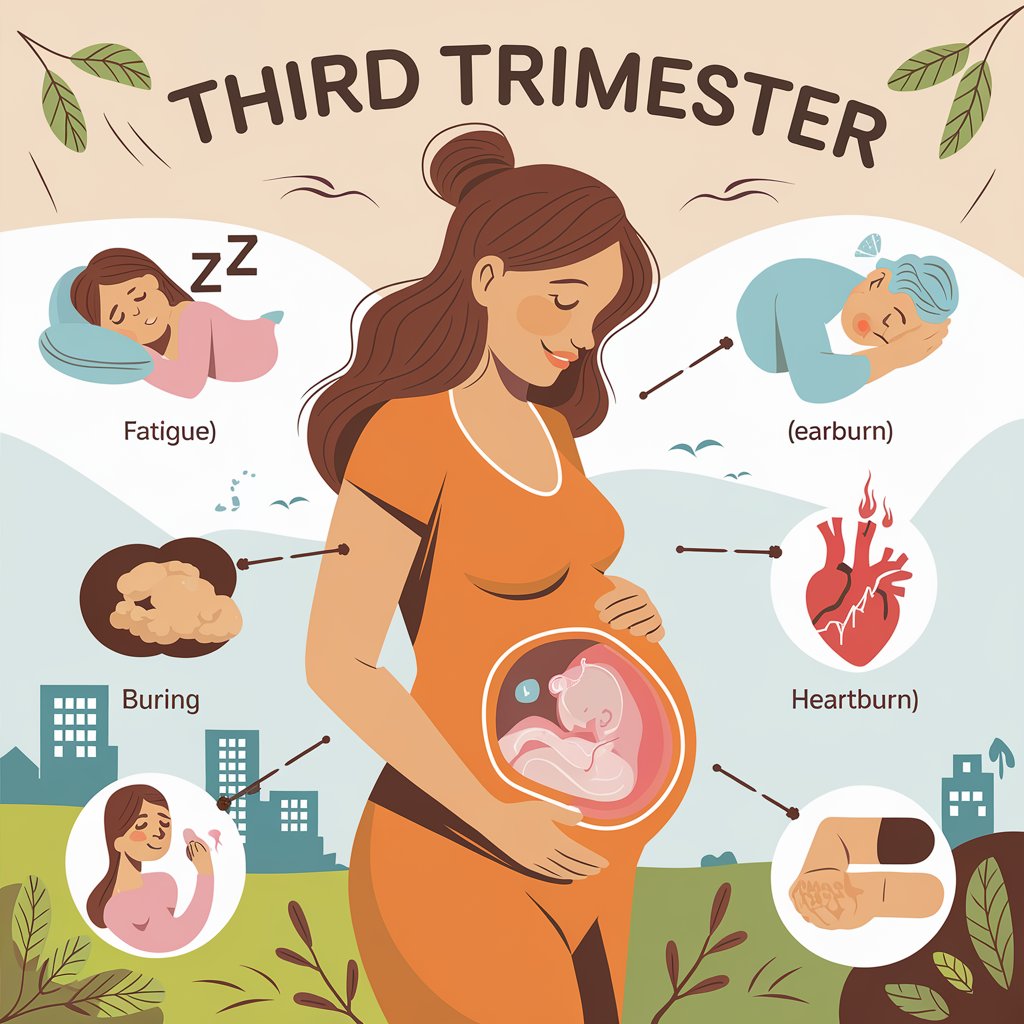The third trimester of pregnancy, spanning from weeks 28 to 40, is a critical time filled with significant changes for both the mother and the baby. This phase marks the final stretch before welcoming your little one into the world, and it’s essential to understand what to expect during this period. This comprehensive guide will take you through the week by week third trimester experience, covering fetal development, common maternal symptoms, and tips for navigating the journey ahead.
Overview of the Third Trimester
The third trimester is a transformative period in pregnancy. As the baby grows rapidly, many changes occur in the mother’s body as well. This trimester is crucial for the baby’s development, especially in terms of physical growth and the maturation of various systems, including the respiratory and immune systems.
During this time, mothers may experience a wide range of physical and emotional changes. It’s essential to maintain regular prenatal visits to monitor the health of both mother and baby. Understanding these changes can help alleviate fears and prepare for labor and delivery.
Week 28: Entering the Final Stretch
Fetal Development
By week 28, the fetus is around 14.8 inches long and weighs about 2.2 pounds. This week marks the beginning of the third trimester, and significant brain development occurs. The baby’s brain is becoming more complex, and fat accumulation begins to give the fetus a more rounded appearance.
Common Maternal Symptoms
Expectant mothers may experience symptoms such as:
- Back Pain: As the baby grows, the additional weight can lead to discomfort in the back.
- Heartburn: Due to hormonal changes and physical pressure from the growing uterus, many women report increased heartburn.
Tips for Comfort and Care
To alleviate discomfort, consider:
- Wearing supportive clothing to reduce back pain.
- Staying hydrated and eating smaller, more frequent meals to combat heartburn.
Week 29: Preparing for the Baby’s Arrival
Fetal Development
At 29 weeks, the baby’s movements are more pronounced as they have less space to maneuver. The baby’s position may shift frequently as they prepare for delivery.
Prenatal Visits and Screenings
This is an essential time for prenatal visits, including screenings for gestational diabetes and discussions about the birth plan. These visits can help monitor the baby’s growth and ensure everything is progressing well.
Nutrition Tips
Focus on foods that support fetal development:
- Protein-Rich Foods: Such as lean meats, eggs, and legumes.
- Calcium-Rich Foods: Dairy products, leafy greens, and fortified plant-based alternatives are crucial for bone development.
Week 30: Increasing Discomfort
Physical Changes
As the baby grows, physical changes become more noticeable. Mothers may experience:
- Swelling: Due to fluid retention, especially in the feet and ankles.
- Difficulty Sleeping: As finding a comfortable sleeping position becomes more challenging.
Emotional Changes and Coping Strategies
Many women report feelings of anxiety as they approach the final weeks of pregnancy. Coping strategies include:
- Mindfulness Techniques: Such as meditation or deep-breathing exercises.
- Support Groups: Joining groups for expecting mothers can provide a sense of community and support.
Recommended Exercises
To relieve discomfort, consider:
- Prenatal Yoga: Helps with flexibility and relaxation.
- Walking: A low-impact way to stay active and manage weight.

Week 31: Development of the Immune System
Fetal Development
By this week, the baby’s immune system is developing, preparing them for life outside the womb. The baby is now about 16 inches long and weighs around 3.2 pounds.
Maternal Symptoms
Expectant mothers may experience:
- Braxton Hicks Contractions: These practice contractions can begin as the body prepares for labor.
- Fatigue: As the body works hard to support the growing baby.
Nutritional Focus
Iron is crucial during this stage for both the mother and baby. Foods to include are:
- Leafy Greens: Such as spinach and kale.
- Lean Meats: Like chicken and turkey, which are rich in heme iron.
Week 32: Baby’s Final Growth Phase
Fetal Development
By week 32, the baby is growing rapidly, gaining weight and fat. Their organs continue to mature, and they may start to respond to sounds from outside the womb.
Common Discomforts
Mothers may experience:
- Shortness of Breath: As the growing uterus pushes against the diaphragm.
- Increased Back Pain: Due to the weight of the baby.
Tips for Creating a Birth Plan
Discuss with your healthcare provider about:
- Labor Preferences: Such as pain management options and support persons.
- Emergency Procedures: Knowing what to expect can reduce anxiety.
Week 33: Preparing for Labor and Delivery
Fetal Positioning
Around week 33, many babies start to position themselves head-down, preparing for delivery. This is an important milestone as the baby’s head will eventually engage with the birth canal.
Signs of Labor
Expectant mothers should be aware of the signs of labor, which may include:
- Regular Contractions: That become more intense and frequent.
- Water Breaking: This could indicate the onset of labor.
Importance of Childbirth Classes
Attending childbirth classes can equip parents with the knowledge and skills needed for labor and delivery, covering:
- Pain Relief Options: Such as epidurals or natural pain management techniques.
- Breastfeeding Basics: Preparing for post-delivery feeding.
Week 34: Strengthening the Baby’s Lungs
Fetal Development
At 34 weeks, the baby’s lungs are developing and preparing for breathing air. They may also begin to practice breathing movements, which helps strengthen the respiratory system.
Maternal Physical Changes
Mothers may notice:
- Increased Braxton Hicks Contractions: As the body prepares for labor.
- Emotional Changes: Such as nesting instincts, where mothers feel compelled to prepare the home for the baby.
Suggested Activities for Relaxation
Engaging in calming activities can help manage stress:
- Prenatal Massage: Can alleviate tension and promote relaxation.
- Bonding Activities: Discuss baby names or create a nursery theme together.
Week 35: Packing for the Hospital
Checklist of Essentials
As the due date approaches, it’s time to pack your hospital bag. Here’s a comprehensive checklist:
- For Mom:
- Comfortable clothing and toiletries.
- Insurance and identification documents.
- Items for relaxation (e.g., books, music).
- For Baby:
- Onesies and blankets.
- Car seat for safe transport home.
Discussing Birth Preferences
This week is an excellent time to talk with your healthcare provider about:
- Labor Preferences: Discuss your desires for the birthing process.
- Postpartum Care: Ensure you know what to expect after delivery.
Week 36: Last-Minute Preparations
Common Symptoms
Mothers may experience:
- Increased Fatigue: As the body prepares for labor.
- Nesting Instincts: A strong desire to prepare the home for the baby.
Final Touches on Nursery Setup
Now is the time to ensure everything is ready:
- Setting Up the Crib: Ensure it meets safety standards.
- Organizing Baby Clothes and Supplies: Keeping essentials accessible.
Week 37: Full-Term Status
Explanation of Full-Term Pregnancy
At 37 weeks, the pregnancy is considered full-term, meaning the baby is ready for delivery. The baby is typically around 19 inches long and weighs about 6.5 pounds.
Physical Changes
Women may notice:
- Increased Braxton Hicks Contractions: Preparing the body for labor.
- Pelvic Pressure: As the baby drops into the pelvis.
Importance of Postpartum Planning
It’s crucial to have a plan in place for after delivery, including:
- Support Systems: Arranging help from family or friends.
- Mental Health: Discussing postpartum depression with a healthcare provider.

Week 38: Anticipating Labor
Fetal Positioning
The baby’s position can change as they prepare for birth. Expecting mothers may feel:
- Increased Movement: As the baby settles into a position for delivery.
Recognizing Signs of Labor
Be vigilant about recognizing labor signs:
- Consistent Contractions: That become increasingly painful.
- Change in Vaginal Discharge: Such as the loss of the mucus plug.
Staying Comfortable
As the due date approaches, it’s essential to prioritize comfort:
- Hydration and Nutrition: Eating small, nutritious meals can help maintain energy levels.
Week 39: Ready for Baby’s Arrival
Last-Minute Check-Ins
Mothers should schedule a final check-in with their healthcare provider. This visit may include:
- Monitoring Baby’s Heart Rate: Ensuring the baby is thriving.
- Discussion of Delivery Plans: Confirming the hospital or birthing center’s protocols.
Common Fears and Anxieties
It’s normal to feel anxious before delivery. Address these feelings by:
- Discussing Concerns: Talking to a partner or healthcare provider can provide reassurance.
- Visualizing Positive Outcomes: Practicing relaxation techniques to stay calm.
Importance of Self-Care
Take time for self-care activities to help manage stress:
- Gentle Exercise: Such as walking or prenatal yoga can promote relaxation.
- Mindfulness Practices: Engage in meditation or deep-breathing exercises.
Week
40: Welcome to the World!
What to Expect During Labor
Labor may begin with contractions or the water breaking. Here are key points to remember:
- Timing Contractions: Understand when to go to the hospital based on contraction frequency.
- Pack Your Hospital Bag: Ensure you have everything ready to go.
Importance of a Support System
Having a support system during labor is crucial. Ensure your partner or support person is prepared to:
- Advocate for Your Preferences: Discuss your birth plan and preferences.
- Provide Emotional Support: Being present can ease anxiety.
Postpartum Care Tips
After delivery, focus on recovery:
- Rest and Nutrition: Prioritize healing and nourishing your body.
- Reach Out for Help: Don’t hesitate to ask for support from family or friends.
FAQ Section
- What are the key developments in the third trimester?
- The third trimester is marked by significant fetal growth, including the development of the brain, lungs, and immune system. Maternal changes include increased fatigue and discomfort as the body prepares for labor.
- What symptoms are common during the third trimester?
- Common symptoms include back pain, heartburn, shortness of breath, and Braxton Hicks contractions. It’s essential to manage these discomforts through self-care and communication with healthcare providers.
- When should I contact my doctor during the third trimester?
- Contact your doctor if you experience severe headaches, vision changes, decreased fetal movement, or signs of preterm labor (consistent contractions or water breaking).
- How can I prepare for labor and delivery?
- Attend childbirth classes, discuss your birth preferences with your healthcare provider, and create a hospital bag checklist to ensure you’re prepared.
- What should I include in my hospital bag?
- Include comfortable clothing, toiletries, insurance documents, and baby essentials like onesies and a car seat.
- How can I manage anxiety as my due date approaches?
- Practice mindfulness techniques, engage in calming activities, and discuss your concerns with your partner or support person.
Conclusion
The week by week third trimester is a time of anticipation and preparation. Understanding the changes your body and baby are going through can empower you during this final stretch of pregnancy. By focusing on self-care, preparing for labor, and having a plan in place, you can navigate this exciting time with confidence and ease. As you prepare to welcome your baby into the world, remember to enjoy these last weeks of pregnancy, knowing that you are embarking on an incredible journey into motherhood.
Read More: Week by Week First Trimester: Your Guide to Every Stage
First Trimester Health Tips: Essential Guidance for New Moms











1 thought on “Week by Week Third Trimester: A Comprehensive Guide for Expecting Mothers”